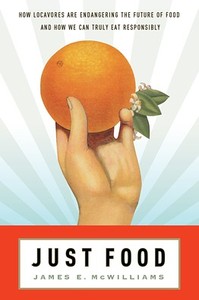Source of book image: http://si.wsj.net/public/resources/images/OB-EH374_justfo_DV_20090821150506.jpg
(p. A23) Grass-grazing cows emit considerably more methane than grain-fed cows. Pastured organic chickens have a 20 percent greater impact on global warming. It requires 2 to 20 acres to raise a cow on grass. If we raised all the cows in the United States on grass (all 100 million of them), cattle would require (using the figure of 10 acres per cow) almost half the country’s land (and this figure excludes space needed for pastured chicken and pigs). A tract of land just larger than France has been carved out of the Brazilian rain forest and turned over to grazing cattle. Nothing about this is sustainable.
Advocates of small-scale, nonindustrial alternatives say their choice is at least more natural. Again, this is a dubious claim. Many farmers who raise chickens on pasture use industrial breeds that have been bred to do one thing well: fatten quickly in confinement. As a result, they can suffer painful leg injuries after several weeks of living a “natural” life pecking around a large pasture. Free-range pigs are routinely affixed with nose rings to prevent them from rooting, which is one of their most basic instincts. In essence, what we see as natural doesn’t necessarily conform to what is natural from the animals’ perspectives.
For the full commentary, see:
JAMES E. McWILLIAMS. “The Myth of Sustainable Meat.” The New York Times (Fri., April 13, 2012): A23.
(Note: the online version of the commentary has the date April 12, 2012.)
McWilliams’ book on related issues, is:
McWilliams, James E. Just Food: Where Locavores Get It Wrong and How We Can Truly Eat Responsibly. New York: Little, Brown and Company, 2009.

